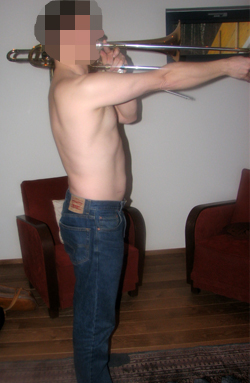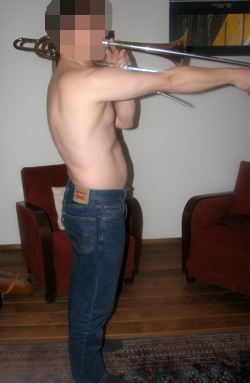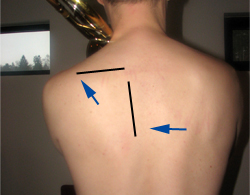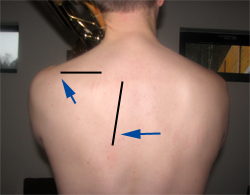Trombone - harjoittelu
Pasuuna
Read the Ergonomics Overview first.
The body's centre position is the basic position to which the musician always returns. In the centre position, the spine maintains its natural curves. Spinal curves vary between individuals; in the centre position, the backs and hips of different people may look different.
In order to find the optimal posture, trombonists should first examine their pelvic position. The pelvis should be in the centre position so that the muscles supporting the pelvis and the spine can work freely (the ischia point directly downwards in a seated position). The trombone is a heavy instrument, and the musician needs strong shoulder blade muscles as well as good control of the midriff muscles.
The thoracic spine should also be in the centre position to ensure a mobile rib cage and correct breathing. When the thoracic spine is in the centre position, the breastbone is in a vertical position and the back extensors are engaged but not tense. During inhaling, the rib cage can expand freely in all directions, including sideways and backwards. The rib cage/thoracic spine and the pelvis should be aligned when viewed from the side. If the thoracic spine tilts backwards in relation to the pelvis, rib cage and diaphragm movement is affected and the musician's breathing suffers as a consequence.
The centre position of the head and neck can be found by first moving the head back and forward, then leaving it in the centre position where there is free movement between the skull and the cervical spine. The position of the neck, head and jaw joints has an effect on the control of neck muscles, jaw muscles and throat muscles. The head and the neck should be in the centre position to facilitate good support for the head from the deep neck muscles. These support muscles enable the superficial muscles to relax. If the head pushes forward (often as a result of a faulty position in the lower spine), it increases tension in the neck muscles, jaw muscles and superficial neck muscles, which can affect the playing technique.
|
The pelvis, thoracic spine, head and neck are in the centre position, the right-hand shoulder blade is supported correctly, and the bottom corner ! otates outwards sufficiently. |
The spine tilts forward, the thoracic spine curves forward; the shoulder blade is poorly supported, increasing the strain in the upper arm and the neck and shoulder area. |
A correct position of the thoracic spine and the rib cage enables optimal muscular support for the shoulder blades. The shoulder blades should be in a vertical position against the ribs, encouraging a natural position of the shoulders. If the shoulder blade tilts forward and/or wings off of the ribs, the shoulder blade support muscles cannot function correctly, affecting the mobility of the rib cage. The three-dimensional movement of the shoulder blade can be difficult to perceive, and the musician may require professional help during shoulder blade exercises.
Trombonists are often prone to tilting their pelvis forward (the pubic bone rotates forward, causing the lumbar spine to extend). When the pelvis is rotated forward, the superficial abdominal muscles relax and inhaling feels freer. An excessive forward tilt of the pelvis can cause overexertion in the upper limbs and the neck and shoulder area. When the pelvis is in the centre position, the breathing improves so that the muscles between the ribs are engaged and expand the rib cage further back and sideways. The abdomen also inflates less during inhaling.
In order to maintain the correct posture, trombonists need good control of the midriff muscles as well as strength and coordination; especially in the left-hand shoulder blade support muscles, since the instrument is mostly supported with the left side of the body.
|
Poor muscular support of the left-hand shoulder blade. The shoulder blade drops, and the bottom corner rotates towards the spine. |
The right-hand shoulder blade is supported correctly; the bottom corner rotates outwards sufficiently when holding the instrument. |
For trombonists, a typical faulty position involves poor muscular support of the left-hand shoulder blade. As a result, the shoulder blade slides away from the spine, tilts forward and fails to rotate outwards. This position often causes the spine to twist to the left, forcing the head to the right and the trombone to the left. This twisting tendency increases during extreme slide movement, when the right arm extends in front of the torso. With good body control and muscular strength, trombonists can maintain a good posture. Because the trombone can take control of the musician's body, the correct posture should be established at an early stage of the studies. Large, heavy instruments should not be used too early.
An instrument that is too large or too small can deteriorate a child's posture and prevent him or her from finding and developing the right technique. A brass instrument support (Ergobrass) can be used during instruction. The instrument is supported with an adjustable stand.
Pushing the head and the neck forward is relatively common among brass musicians. The pelvis and the lumbar spine have some effect on the position. If the pelvis tilts forward, the head also pushes forward. For some musicians, pushing the head forward is pure habit. Concentrating on bringing the instrument to the lips (rather than taking the lips to the instrument) helps to maintain the neck and the head in the centre position. Mirrors are useful in eliminating incorrect movement.
In a seated position, the strain on the mid-back extensors is slightly higher compared to a standing position, as the centre of mass is further out.




